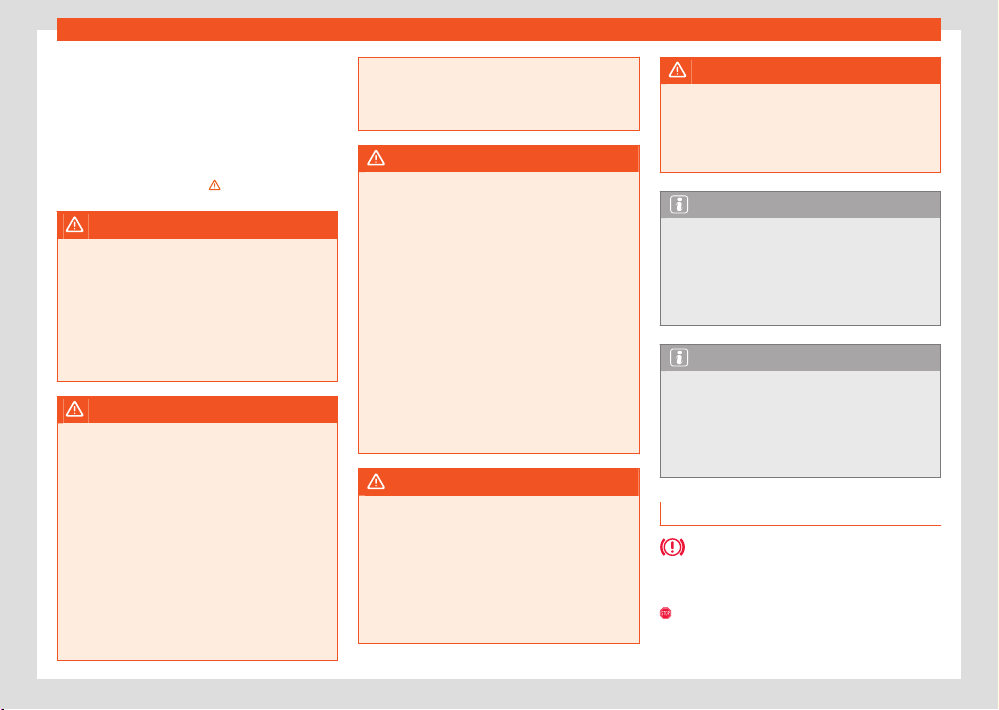Loading ...
Loading ...
Loading ...

Driving
173
Braking system
Corrosion on the br
ake discs and dirt on the
brake pads increase if the vehicle is left unused
for a long time, if it is not driven for many kilo-
metres. If corrosion is present, it is recommen-
ded to clean the discs and pads by braking
hard several times while driving at high speed.
Make sure that you do not endanger any other
vehicles or road users ›››
.
WARNING
Driving with worn brake pads or a defective
br
ake system can lead to accidents and seri-
ous injuries.
●
If you suspect that the brake pads are worn
or that the brake system is faulty, have the
brake pads checked immediately by a spe-
cialist workshop and replaced if they are
worn.
WARNING
The braking performance of new brake pads
is not optimal.
●
During the first 300 km, ne
w brake pads do
not provide maximum braking power and still
have to “settle”. This can be counteracted by
applying more pressure to the brake pedal.
●
When brake pads are new, drive with extra
care to reduce the risk of accidents, serious
injury or loss of control of the vehicle.
●
Only perform hard braking to clean the
brake system when permitted by the trac
situation. Do not endanger the occupants of
other vehicles. Accident hazard!
●
When running in new brake pads, do not
driv
e too close to other vehicles or cause sit-
uations that would require the brakes to be
applied heavily.
WARNING
When the brakes overheat, their braking per-
f
ormance drops and the braking distance in-
creases.
●
When driving downhill, particular demand
is placed on the brakes and they heat up
very quickly.
●
Before a long steep slope, reduce speed
and change down into a lower gear or range.
Therefore, using the engine brake relieves
the brakes.
●
If you wish to retrofit a front spoiler, inte-
gral trim or other accessories, ensure that
the air inlet around the brakes is not reduced,
as otherwise the brake system could over-
heat. Please also note the information on
brake fluid ›››page335.
WARNING
Wet, frozen or salt-covered brakes take lon-
ger to brake and increases the braking dis-
tance.
●
Test the brakes carefully.
●
Always dry the brakes and free them from
ice and salt by braking repeatedly, if permit-
ted by visibility, weather, road surface and
trac conditions.
WARNING
When braking manoeuvres are started auto-
matically, the br
ake pedal may move auto-
matically in the application direction. Do not
put your foot under the brake pedal. Risk of
injury!
Note
Never let the brakes “drag” by leaving your
f
oot on the pedal when it is not necessary
to brake. This can cause the brakes to over-
heat, resulting in increased brake travel and
wear. Please consider the important notes on
brake fluid ›››page335.
Note
Regularly check the thickness of the brake
pads visually thr
ough the holes in the rims
or from the underside of the vehicle. If nec-
essary, the wheels should be removed for
a more thorough inspection. SEAT recom-
mends visiting a SEAT dealership for this.
Troubleshooting
Defect in the brake system
The w
arning lamp lights up red. A message
may also be displayed.
St
op driving!
Loading ...
Loading ...
Loading ...